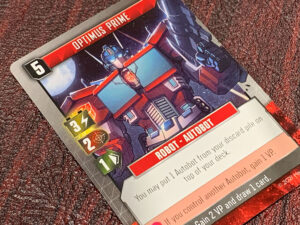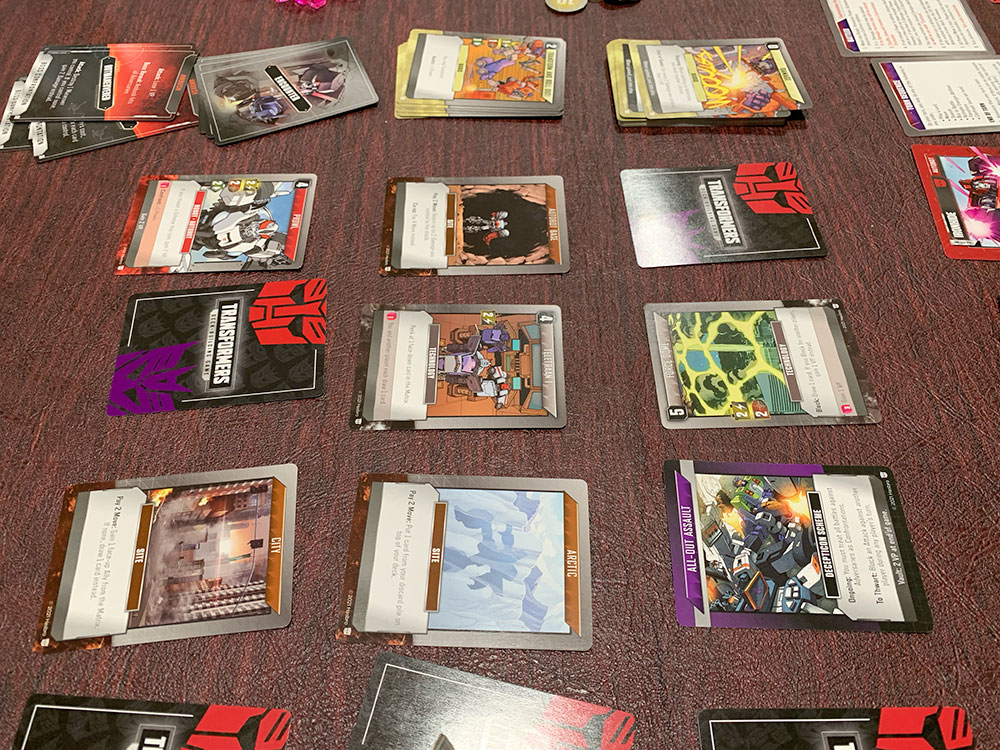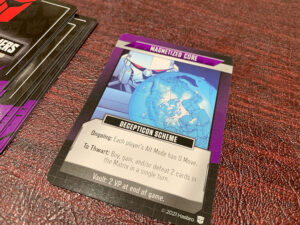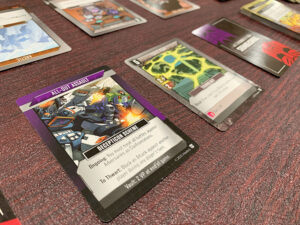 For all the Michael Bay movie fans out there, sorry, but this is not the new Transformers. The game under scrutiny today is a blast from the 80s where the robots were more blocky and showed up after-school on a UHF channel. That means broadcast television for our younger readers perusing this article.
For all the Michael Bay movie fans out there, sorry, but this is not the new Transformers. The game under scrutiny today is a blast from the 80s where the robots were more blocky and showed up after-school on a UHF channel. That means broadcast television for our younger readers perusing this article.
Like GI Joe, Thundercats, and Masters of the Universe, Transformers was a franchise of action-adventure characters with a marketable toy lineup. What made Transformers even more interesting is that the characters could be folded and “transform” into a toy vehicle. Perfect for parent company Hasbro.
So, here we are with the board game. It’s a deck builder, which seems appropriate, and allows for modifications to the deck-building style that takes into account the Transformers narrative allowing for multiple game modes where the Autobots (our heroes) take on the Decepticons (the villains) in solo, cooperative, and competitive variants. The Transformers Deck-Building Game is for 1-5 players and takes up to 90 minutes to play. For the best experience, start with a solo game then add in up to 4 players.
Gameplay Overview:
The setup for each game features a grid of facedown cards called the Matrix. This forms the supply of cards to be bought or defeated depending on what card shows up when revealed. On top of the grid, players use standees representing their Autobot characters to move from card to card.
Otherwise, the preparation features a prepared deck with various Decepticon adversaries and Bosses waiting to arrive into the play area. The deck also features other cards with abilities and Autobot allies prepared to provide resources that the player uses turn after turn: Move, Power, Range, and Energon. Some of a player’s Move resource is also provided by the Autobot character cards (not in the deck) which can be flipped during a turn to allow a player to be in a fighting stance (robot) or a moving (vehicle) mode.

During a turn, a player can move their Autobot from card to card by playing cards with the Move resource. They may also use this to reveal a face-down card. If the card is an enemy the player must draw from a deck with negative effects (Encounter cards). If it’s any other card, they may be able to purchase it.
Players purchase or fight cards using the Power resource. A player must play power equal to or greater than the cost of an enemy to defeat it. If they succeed, the enemy is placed in the player’s Vault for end-game points.
The Range resource is needed to use a card’s Power resource at a specific distance to other cards in the grid. For example, a card with 2 Power and 2 Range can purchase cards of 2 Cost or less that are up to 2 spaces away. If several cards with Range are played together, only the lowest Range applies to the total.
Finally, the Energon resource can be spent on a turn to allow Autobots to transform or use some card-specific abilities. This resource regenerates as players play a certain card in their deck.
The competitive and cooperative versions of the game are similar with the main difference being that players must also deal with Scheme cards which change the game rules to make defeating enemies or moving through the Matrix more difficult. The more that players build up their decks by buying cards, the more likely they will encounter enemies and Schemes and have to deal with a boss enemy.
One final card worth mentioning are Site cards. Once discovered, these stay in play and allow players to gain some bonus when their standee is on the card.

Game Experience:
With so many iterations since Dominion and Ascension, deck-building games have a few genre conventions by this point. There are standard cards to purchase resources and there are also some cards that might provide detriments or delay the player’s progress. In the overall design concept of the Transformers Deck-Building Game, it doesn’t seem as if this philosophy is present. This aspect of the criticism deserves a little bit of explanation so allow this reviewer some patience while this negative is explored.
Not all deck-builders, but many of them, have a central loop of play as a player will cycle through their deck. In the early game, players will want to focus on acquiring abilities and improving their deck a few cards at a time. These early purchases are what fuel a player’s deck the most. In addition, early gains of negative resources or delays from unfulfilled expenditure of resources will dramatically impact how player’s speed in progressing in power through the game. Designers need to be aware of how many deck cycles a player will go through and what resources they will be able to acquire turn to turn.

As far as can be seen, Transformers does not adhere to this concept. Players simply acquire either from a stack of standard cards which do not increase a player’s Power resource or must move around the grid constantly in search of cards that can be acquired. The 5 card hand doesn’t always allow for players to gain enough power on a turn to purchase cards, so they must wait a turn or two or seek out more cards. This expenditure of movement slows play down without offering any excitement. So if other players get lucky by discovering cheap, usable cards, they gain resources faster. This is a fundamental and annoying flaw in the game. The randomness by which cards appear and are acquired drag the enjoyment of the game down to a halt.
While this reviewer can see why the designers wanted the cards to be face-down and enhance the mystery of exploration and discovery, it does not serve the game design’s intent. The movement mechanism as well as the range mechanism feel interesting, but only if they are reworked slightly to allow for more cards to be seen. In a game such as this with a board state, these two resources get in the way of each other and aren’t harmonized well.

Not only the above, but the Sites and Enemies can fill up the game state quickly making it difficult to find new cards to purchase, and, again, slow down the deck cycle. It’s unclear to this reviewer how this game was playtested without uncovering these issues. As it is, the game is functional and holds interest for a game or two, but these failings appear fast and are quick distractions.
And, if that wasn’t enough, the progress of play is additionally unnecessarily complex given the underlying IP. The game tries to shoehorn in multiple resources and unenjoyable challenges in a game which really should be fast and simple. More than one player at our gaming table complained of the complexity of achieving some simple tasks with such paltry handouts of choices to build decks. This is not the enjoyable part of deck building. This wouldn’t be so bad, but the game also requires players to dump their entire hand every turn, not even allowing some agency over the timing of a card’s usage.
Final Thoughts:
Transformers Deck-Building Game is not fully baked. It has good concepts. It has interesting mechanisms, but on the whole, it asks too much of players and relies too much on randomness even for a casual evening of gaming. Even then, once players have digested those concepts and accepted the random draws, it bogs down when negative cards are revealed and the few purchasable cards show up without enough resources to purchase them. It’s a disappointing affair with such a promising IP and ideas, but this is a game that won’t be rewarding except to those desperate to enjoy the IP.
Final Score: 2 Stars – A near fatally-flawed deck builder that asks too much from players and offers too little in return.
 Hits:
Hits:
• Gets the feeling right for the Transformers IP
Misses:
• Overly complex
• Not enough player agency
• Game can stall during play






















This is hilarious. Mattel? It’s HASBRO. I stopped reading until I saw the final score. I give this review 2 out of 5 stars
Entire review on a game, it’s mechanics and gameplay experience are void because the owning company for OG Transformers was stated wrong? Hilarious. How does that have any impact in the board game review at all? Some people just want to have a petulant whine.
Thanks for that catch Scott H. I appreciate your enthusiasm for the process of review writing and the need to get the details right so that Scott W can be saved from pointing out the impact of your comment. Game on!
Thanks for the review – I succumbed to nostalgia and bought this though i have yet to open or play it. Planning for solo only, my wife has no interest. Is it worth playing even solo, or would it be better to keep it sealed and try to recoup some losses by selling it?
I don’t think it will hold up to expectations for solo play.
I had really wanted to like this one. Deck builders? Yes, please. Transformers? Yes, please. I enthusiastically grabbed it when it was on sale, and was also excited by the G.I. Joe version, and hoped I could combine the two eventually. When it arrived, I was impressed with the G1 art, read the rulebook and it was a bit confusing. I tried to play solo so I could teach the game to others. It never quite made sense to me, although I thought I was playing correctly.
I agree, the theme is nicely implemented. I almost wish the matrix were just events and enemies and there was a standard recruit mechanic instead of the mess this current game is in. I might have to try it that way. In the end, it kind of reminds me of the Star Trek deck building game, which I also had high hopes for. It also had a unique mechanic, interesting setup, but VERY bad rulebook and not very fun to play because it is more frustrating than anything else.
Good review, and I was sad it validate the problems I had with it.